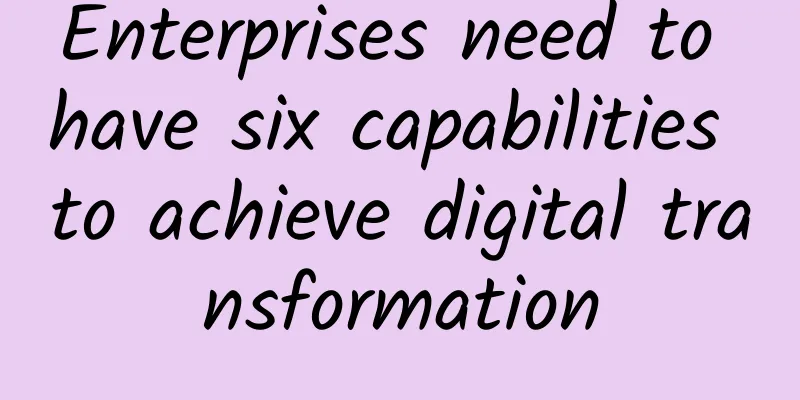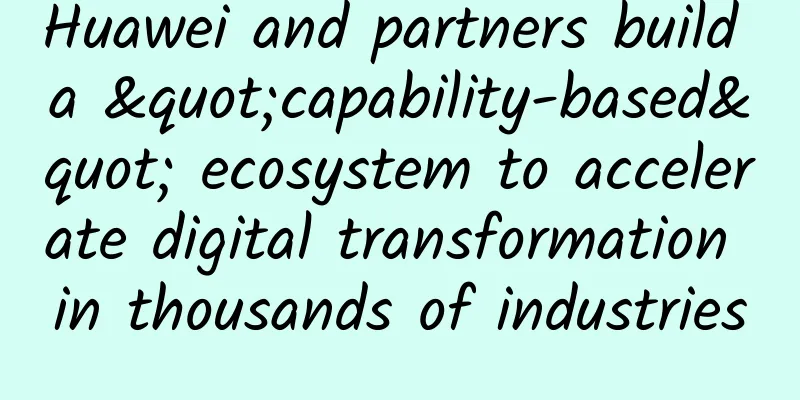Enterprises need to have six capabilities to achieve digital transformation

|
As we step into the 21st century, the wave of digitalization has helped the world economy to usher in a leap-forward transformation. Looking around the world, whether it is traditional banking, manufacturing, retail, or media entertainment and education, they have all begun to actively implement the transformation of digital strategies, and a new trend of transformation to fully digital and automated enterprises has emerged. With the power of digital, enterprises will focus on user experience while reshaping the technological foundation to create more value. However, constrained by limited budgets and a shortage of technical talent, many companies choose to remain stagnant in their core businesses and only innovate in marginal businesses. Conservative corporate operating models and cultures, lack of adaptive risk management and security strategies, applications and infrastructure that rely on manual intervention, and lack of insightful technical capabilities have become key issues hindering corporate development. As digital transformation drives enterprises towards the goal of adaptability, enterprises need to rely on the application of innovative technologies to solve the pain points in the above areas in order to improve the efficiency and speed of enterprises, unleash their adaptability and innovation capabilities, and thus lead the realization of digital transformation . The three phases continue to advance, and digitalization drives business innovation The core of digital transformation is to achieve innovation through business and technology optimization. Even though digital transformation has become the main theme of corporate strategic transformation, if companies want to use digital transformation to lead change, they need to identify their own technical capabilities, follow their own development status and the characteristics of each stage of corporate development, and thus create a customized transformation strategy. We divide the digital transformation of enterprises into three stages: The first stage is task automation. In this stage, by introducing applications into business processes, complex manual tasks are turned into automated execution to improve efficiency. The second stage is digital expansion. In this stage, as enterprises begin to use cloud-native infrastructure and software development to achieve automation, a new generation of applications will achieve digital expansion, so that the entire enterprise end-to-end process can be completed through digitalization. The third stage is AI-assisted business. Entering this stage, as the digitalization process of enterprises deepens, application platforms, telemetry technology, data analysis, machine learning (ML) and artificial intelligence technology will be integrated into the business processes of enterprises, and AI-assisted business will improve the productivity of enterprises. Research from F5's "2022 Application Strategy Status Report" and a large number of industry examples have verified that most companies are now in the second stage of digital transformation development. This stage is characterized by a focus on the modernization of applications and operations, and an increasing tendency to adopt cloud and edge technologies to accelerate innovation and development. Grasp the six major technical capabilities to accelerate enterprise digital transformation The urgent pursuit of digital transformation by enterprises has made the promotion of a new digital IT architecture inevitable, but today's mainstream enterprise IT architecture lacks factors such as agility, scale, security and observability, which are the key to promoting technological change and avoiding increasingly complex cyber attacks. Therefore, we have summarized the six core technical capabilities that enterprises must have to help them cope with the risks and challenges they face in the ever-changing digital transformation process. IT Infrastructure The acceleration of digital transformation has driven the rapid distribution of society, users and applications to the cloud and edge, and the traditional enterprise infrastructure architecture has been replaced. Today's enterprise IT infrastructure is providing system, network and storage resources in data centers, clouds and edge environments in a unified and more efficient way. It is no longer fixed or static, but based on dynamic and distributed concepts, providing resource elasticity that supports other infrastructure environments. Safety Security is a key area of enterprise digital transformation, and security deployment and policy execution need to permeate every IT application architecture. The tools and technologies for executing security policies and providing digital businesses with the insights needed to manage risk will vary depending on the application architecture. We have found that enterprises still have a wide range of needs for detecting and eliminating security threats, but not at the expense of business. In addition, traditional binary security strategies based on rigid IT architectures will no longer serve the business and may even become an obstacle to enterprise development. Therefore, enterprises need to find the necessary balance between security and performance in their risk strategies. data Even under traditional architectures and strategies, enterprise data can function normally in today's environment. However, enterprises now need to expand data to break down data silos, including using telemetry to collect real-time operational data, implementing new strategies to provide more accurate and sharp insights, and promoting automation and decision-making. In addition, traditional data strategies should also be modernized to adapt to and meet the needs of relevant users and compliance with business data privacy policy requirements. Application distribution and delivery Application delivery has become an important part of the technical capabilities in enterprise IT architecture. The practice and technology of application delivery has evolved and matured with the advent of the Internet. It has now become a necessary technical capability to scale, distribute and deliver applications (which have become the digital assets of modern enterprises). With the increasing pressure to improve performance and users' expectations for digital experiences, enterprises need to provide applications and digital services to meet the challenges. This will inevitably put application delivery on the technical agenda to distinguish it from the infrastructure traditionally associated with it. Observability and Automation The adaptability of any organism is closely related to its ability to receive signals and automatically adjust. Just like life, a digital enterprise must have access to the most robust set of digital signals possible to ensure that it can process and analyze signals and make adjustments based on changes in the internal and external environment. Observability injects the digital enterprise with the signals (i.e., data) it needs to make adjustments with minimal human intervention (i.e., automation). With observability and automation, enterprises can obtain a full-scale, closed-loop feedback path, which will allow technology leaders to focus on innovation and business improvement rather than just focusing on business core capabilities. SRE (Site Reliability Engineering) Practice Codifying desired business outcomes into SLOs (Service Level Objectives) and operating the entire digital service with minimal intervention is a new skill that requires new practices and approaches. This is achieved by SRE. Operating a digital business with minimal human intervention means that human governance is still required and sometimes action is required. SRE fills the need to operate a digital business based on data, by leveraging automation and focusing on meeting SLOs tied to business outcomes rather than purely technical measures. Adopting SRE is a critical, organizational change that is necessary in order to effectively operate a digital business and fully leverage the benefits of data and automation. Work hard and persevere to achieve perfection. For enterprise CIOs and IT leaders, if they want to accelerate the digital transformation of their enterprises, they need to think about how the enterprise's technical capabilities match their business strategies, thereby helping the enterprise to move forward steadily in an evolving environment and ultimately achieve successful digital transformation. This article is excerpted from the new book "Enterprise Architecture for Digital Business" co-authored by Lori MacVittie, F5's global executive vice president, chief technology officer, chief Chinese scientist, and technical evangelist of F5's CTO office. F5 Global Executive Vice President, Chief Technology Officer and Chief Chinese Scientist Geng Lin |
<<: 5G and its impact on the Internet of Things
>>: WebSocket in real-time chat room
Recommend
A thorough understanding of container network communication
Author | Chen Yunhao (Huanhe) 1. Background 1. Wh...
Network monitoring tool! Don't miss these 7 free open source tools
Editor's note: In the real estate market, the...
Getting started with SD-WAN, just read this article
In 2019, the global market for SD-WAN grew by 70%...
Ruijie-style innovation: Ruijie Networks 2017 product and solution strategy released in Beijing
On March 31, Ruijie Networks held its 2017 produc...
Before 5G mobile phones become popular, these problems must be solved first
Although information about 5G has attracted a lot...
RackNerd July promotion, $14.88/year - 1.2G memory, 18G hard drive, 2TB monthly traffic, 5 computer rooms
RackNerd continued to release several promotional...
E-Dianbao CEO Rulai Chen Tao tells you that the reason behind being No.1 is that he has been focusing on one thing for 13 years
[51CTO.com original article] The interview with C...
How do we correctly interrupt a thread that is executing? ?
[[358852]] The author has developed a simple, sta...
HostKvm Hong Kong B Zone 40% off, $5.1/month KVM-2G memory/40G hard disk/1Gbps bandwidth
HostKvm is a Hong Kong VPS provider founded in 20...
Qeru: $3/month KVM-3GB/40GB/5TB/Dallas Data Center
According to information from LET, Qeru recently ...
The number of 5G package customers has exceeded 165 million. China Mobile announced its operating data for December 2020.
Since the Ministry of Industry and Information Te...
Ten reasons why it's time to retire traditional routers in branch offices
Over the years, we've dutifully upgraded our ...
NAT detailed explanation: basic principles, traversal technology (P2P hole punching), port aging, etc.
Regarding the NAT penetration currently promoted ...
Sharing of views | IoT data requires sharing protocols
IoT devices generate a lot of data, and even thou...
The world's first non-cellular 5G standard has been released, with a higher connection node density than NB-IoT and LTE-M!
Recently, the DECT-2020 NR standard launched by t...









